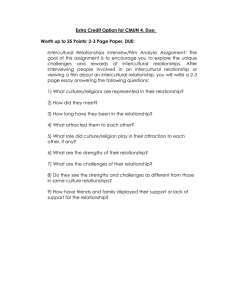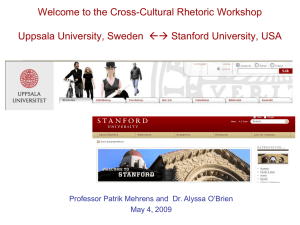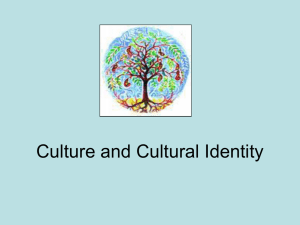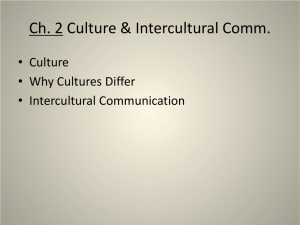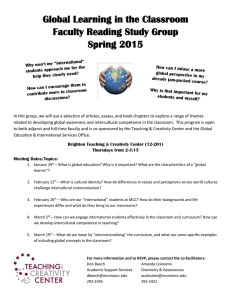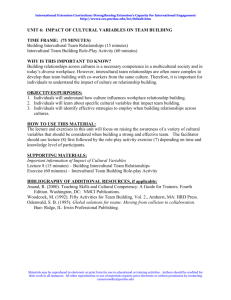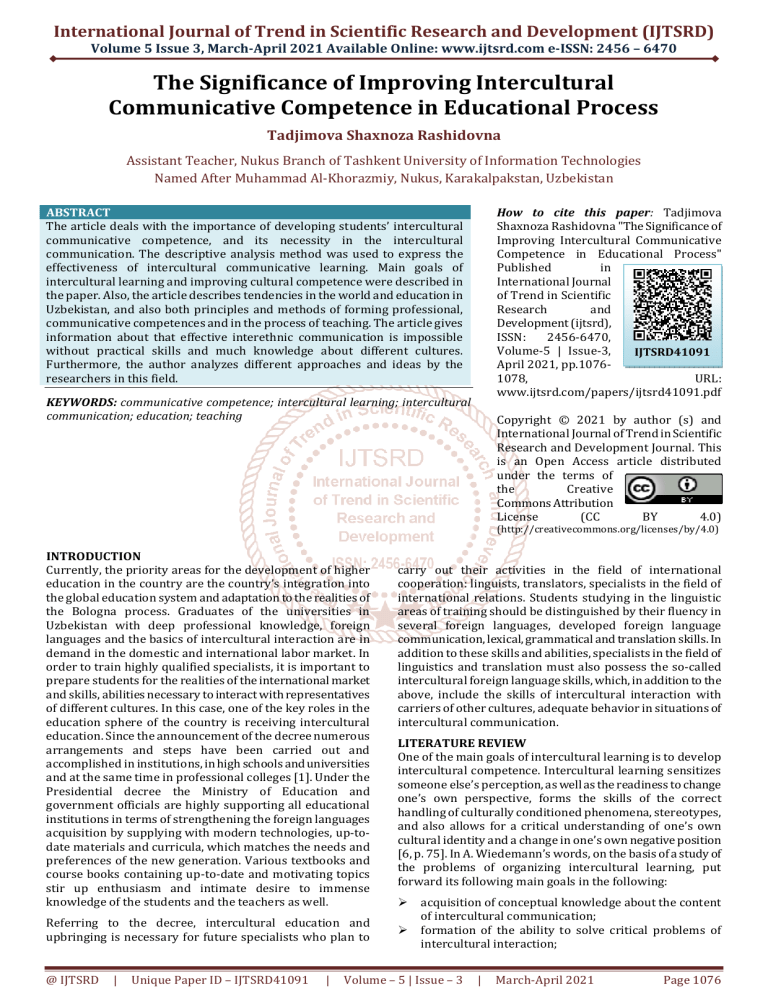
International Journal of Trend in Scientific Research and Development (IJTSRD)
Volume 5 Issue 3, March-April 2021 Available Online: www.ijtsrd.com e-ISSN: 2456 – 6470
The Significance of Improving Intercultural
Communicative Competence in Educational Process
Tadjimova Shaxnoza Rashidovna
Assistant Teacher, Nukus Branch of Tashkent University of Information Technologies
Named After Muhammad Al-Khorazmiy, Nukus, Karakalpakstan, Uzbekistan
How to cite this paper: Tadjimova
Shaxnoza Rashidovna "The Significance of
Improving Intercultural Communicative
Competence in Educational Process"
Published
in
International Journal
of Trend in Scientific
Research
and
Development (ijtsrd),
ISSN:
2456-6470,
Volume-5 | Issue-3,
IJTSRD41091
April 2021, pp.10761078,
URL:
www.ijtsrd.com/papers/ijtsrd41091.pdf
ABSTRACT
The article deals with the importance of developing students’ intercultural
communicative competence, and its necessity in the intercultural
communication. The descriptive analysis method was used to express the
effectiveness of intercultural communicative learning. Main goals of
intercultural learning and improving cultural competence were described in
the paper. Also, the article describes tendencies in the world and education in
Uzbekistan, and also both principles and methods of forming professional,
communicative competences and in the process of teaching. The article gives
information about that effective interethnic communication is impossible
without practical skills and much knowledge about different cultures.
Furthermore, the author analyzes different approaches and ideas by the
researchers in this field.
KEYWORDS: communicative competence; intercultural learning; intercultural
communication; education; teaching
Copyright © 2021 by author (s) and
International Journal of Trend in Scientific
Research and Development Journal. This
is an Open Access article distributed
under the terms of
the
Creative
Commons Attribution
License
(CC
BY
4.0)
(http://creativecommons.org/licenses/by/4.0)
INTRODUCTION
Currently, the priority areas for the development of higher
education in the country are the country’s integration into
the global education system and adaptation to the realities of
the Bologna process. Graduates of the universities in
Uzbekistan with deep professional knowledge, foreign
languages and the basics of intercultural interaction are in
demand in the domestic and international labor market. In
order to train highly qualified specialists, it is important to
prepare students for the realities of the international market
and skills, abilities necessary to interact with representatives
of different cultures. In this case, one of the key roles in the
education sphere of the country is receiving intercultural
education. Since the announcement of the decree numerous
arrangements and steps have been carried out and
accomplished in institutions, in high schools and universities
and at the same time in professional colleges [1]. Under the
Presidential decree the Ministry of Education and
government officials are highly supporting all educational
institutions in terms of strengthening the foreign languages
acquisition by supplying with modern technologies, up-todate materials and curricula, which matches the needs and
preferences of the new generation. Various textbooks and
course books containing up-to-date and motivating topics
stir up enthusiasm and intimate desire to immense
knowledge of the students and the teachers as well.
Referring to the decree, intercultural education and
upbringing is necessary for future specialists who plan to
@ IJTSRD
|
Unique Paper ID – IJTSRD41091
|
carry out their activities in the field of international
cooperation: linguists, translators, specialists in the field of
international relations. Students studying in the linguistic
areas of training should be distinguished by their fluency in
several foreign languages, developed foreign language
communication, lexical, grammatical and translation skills. In
addition to these skills and abilities, specialists in the field of
linguistics and translation must also possess the so-called
intercultural foreign language skills, which, in addition to the
above, include the skills of intercultural interaction with
carriers of other cultures, adequate behavior in situations of
intercultural communication.
LITERATURE REVIEW
One of the main goals of intercultural learning is to develop
intercultural competence. Intercultural learning sensitizes
someone else’s perception, as well as the readiness to change
one’s own perspective, forms the skills of the correct
handling of culturally conditioned phenomena, stereotypes,
and also allows for a critical understanding of one’s own
cultural identity and a change in one’s own negative position
[6, p. 75]. In A. Wiedemann’s words, on the basis of a study of
the problems of organizing intercultural learning, put
forward its following main goals in the following:
acquisition of conceptual knowledge about the content
of intercultural communication;
formation of the ability to solve critical problems of
intercultural interaction;
Volume – 5 | Issue – 3
|
March-April 2021
Page 1076
International Journal of Trend in Scientific Research and Development (IJTSRD) @ www.ijtsrd.com eISSN: 2456-6470
learning foreign languages;
acquisition of social skills;
the formation of tolerance in relation to representatives
of other cultures;
development of the ability to regulate their own
emotions;
awareness of the influence of culture on social
phenomena;
development of the skill to quickly orientate and adapt
in an alien cultural environment;
development of flexibility and adaptability [12, p. 3198].
Communication presupposes that the participants have
communicative competence, i.e. knowledge of the systems of
symbols used in communication and the rules of their
functioning, embodied in the principles of communicative
interaction [13, p. 40]. A person simultaneously belongs to
several groups (family, educational or labor collective, social
class, ethno religious group), and communication within
these groups forms his communicative competence. Larger
groups, national or regional cultures, define cognitive and
pragmatic the basics of the communicative activity of the
individual. According to A.F. Zinovieva, the communication
of each person is conditioned by his individual experience.
When communicating (for example: in the process of
exchanging messages), meanings are constantly being
recreated, and they often do not coincide even among people
who speak the same language and belong to the same
culture. Therefore, when representatives of different
cultures and different languages communicate, the
communication process is significantly complicated [13].
Communication with foreigners does not exclude the
emergence of misunderstandings and conflicts due to
culture, therefore, according to T.G. Stefanenko, effective
interethnic communication is impossible without practical
skills and extensive knowledge about the culture of another
people [9, p. 26]. Intercultural communication is carried out
if the sender and recipient of the message belong to different
cultures, as well as if the participants in the communication
are aware of the cultural differences of each other.
Intercultural communication is always interpersonal
communication in a special context, when one participant
discovers the cultural difference of the other.
METHODOLOGY
In Kalinina’s words, the expansion of intercultural
professional contacts creates the need of society for
specialists of various profiles, fluent in a foreign language.
This allows you to successfully carry out professional
interaction between representatives of different cultures,
presupposes the mastery of professionally significant
concepts of foreign language culture, which determine the
specifics of social and business behavior, conditioned by the
influence of historical traditions and customs, lifestyle and
the successful application of this knowledge in practice [4, p.
25]. According to E.N. Malyuga, participants in the
intercultural interactions use a foreign language with the
simultaneous accumulation of cultural knowledge and the
formation of the ability to understand the mentality of
speakers of another language [5, p. 155]. Matsumoto
describes a model aimed at reducing ethnocentrism by
forming or increasing awareness its manifestations.
Ethnocentrism describes a way of thinking in which other
cultures and communities are assessed from the perspective
of their own culture and in accordance with their own
@ IJTSRD
|
Unique Paper ID – IJTSRD41091
|
norms. Deviation from one’s own cultural values is perceived
negatively, while one's own culture is seen as superior [7, p.
77]. I. A. Sternin also notes that a person can successfully
interact with other cultures only when he develops flexibility
when interacting with other people, at the same time
accepting and realizing his own ethnocentrism [10, p. 94].
Juliana Roth’s model is the most famous and generally
accepted model, reflecting the basic principles and ideas of
intercultural learning in the following:
1. awareness of the cultural specifics of human behavior;
2. awareness of the orientation system characteristic of the
native culture;
3. awareness of cultural factors in the process of
communicative interaction [8, p. 68].
RESULTS AND DISCUSSION
These models of teaching intercultural communication over
time have been formed into various approaches to the
organization of intercultural education and upbringing.
Conventionally, we can distinguish two main approaches
used in the process of intercultural learning, which are
proposed by Russian scientists. The socio-psychological
approach considers intercultural learning as a special way of
forming certain socio-cultural and value-orienting attitudes,
communicative and empathic skills that allow for effective
intercultural interaction, and understand other cultures, be
tolerant towards the carriers of other cultures. The main
idea of this approach can be expressed in the position, G.D.
Dmitriev puts forward that people should be able to interact
with culturally diverse people, be able to correctly
understand cultural differences, be tolerant of other cultures,
as well as see the cultural pluralism of society and accept it
[14, p. 37]. Social competences need to be taken into account
and trained in the process of intercultural learning.
However, learning acquires a complex character thanks to
the use of a different approach, namely the dialogue
approach. N.V. Yankina suggests that the dialogue of cultures
plays a key role in this approach. The dialogue of cultures
involves the inclusion of positive thinking in the
communication of representatives of different cultures, and
value meanings are not blocked, but stimulated due to
mutual understanding, tolerance and positive perception of
each other [14, p. 38]. Also, Pommerin is one of the theorists
of intercultural communication, defines that intercultural
learning as a response of pedagogy to the changing reality of
the multicultural world, as well as a contribution to
education by overcoming and resolving intercultural
conflicts.
The study of the theoretical foundations of intercultural
communication is a necessary element of intercultural
education and upbringing. As a rule, the very concept of
intercultural communication is considered, its formation and
development as a scientific discipline, relationship with
others sciences. An important point is the consideration and
study of key phenomena and concepts encountered in the
field of intercultural communication. One of the central
aspects of teaching intercultural communication is the study
of the cultural characteristics of the carriers of another
culture. Within the framework of intercultural
communication, there are a number of theories that allow us
to consider cultures from one angle or another. The most
famous and widely used in intercultural learning are the
theories of the American anthropologist Hall and a
sociologist Hofstede. Scientists have identified certain
cultural parameters on the basis of which it is possible to
Volume – 5 | Issue – 3
|
March-April 2021
Page 1077
International Journal of Trend in Scientific Research and Development (IJTSRD) @ www.ijtsrd.com eISSN: 2456-6470
analyze one or another culture. Such analysis helps to
understand the peculiarities of the national character,
behavior and way of thinking of representatives of a
particular culture. Thus, it is possible to compare between
different cultures in order to highlight common features and
differences that may hinder effective intercultural
communication.
[4]
Kalinina, E. R., Kabanova, O. V. The role of
intercultural communication in the study of a foreign
language by students of non-linguistic specialties. //
University complex as a regional center of education,
science and culture: materials of the All-Russian
scientific methodological conference. Orenburg:
Publishing house, Orenburg state uni. 2014. pp. 23-28.
CONCLUSION
Thus, having considered two main approaches to
intercultural learning, we can conclude that learning should
be based on the integrated use of both a socio-psychological
and a conversational approach. Despite the similarities,
there are also differences between them. The sociopsychological approach is primarily aimed at the formation
of such qualities as a sense of tolerance and empathy, due to
which the inclusion of other cultures' values and values in
the system of thinking takes place, and also ensures
competent and effective interaction with representatives of
these cultures. In the dialogue approach, the first place is the
formation of certain communication skills, in particular,
conducting a dialogue. Also, Grushevitskaya emphasizes that
dialogue provides a departure from ethnocentrism towards
multiculturalism, and also provides a mutually beneficial
cultural exchange among interacting people [3, p. 79].
[5]
Malyuga, E. N. Mutual influence of business
communication and intercultural business discourse
// Izvestiya RGPU named after A.I. Herzen. St.
Petersburg: Publishing house: Russian State
Pedagogical University named after A. I. Herzen.,
No.84. 2008. pp. 147−155.
[6]
Nohl, A. M. Konzepte interkultureller Pädagogik, Eine
Systematische Einführung. M. Nohl. Bad Heilbrunn:
Verlag Julius Klinkhardt, 2006. 255 p.
[7]
Pushnykh V. A. Intercultural management: textbook.
allowance. Tomsk: Publisher: Tomsk Polytechnic
University. 2011. 180 p.
[8]
Roth, J., Kopteltseva, G. Intercultural communication.
Theory
and
training//Interkulturelle
Kommunikation. Theorie. Training//methodological
manual. Moscow: Unity-Dana. 2015. 224 p.
[9]
Stefanenko, T. G. Ethnopsychology: textbook.
allowance. Moscow: Publishing house Aspect Press,
2000. 208 p.
[10]
Sternin, I. A. An outline of English communicative
behavior. Manual., Voronezh: Publishing house,
Interregional Center for Communication Research.
2003. 185 p.
[11]
Straub, J. Lerntheoretische Grundlagen. Wie lehrt man
interkulturelle Kompetenz? Theorien, Methoden und
Praxis in der Hochschulausbildung. Bielefeld:
transcript Verlag. 2010. pp. 31-98.
[12]
Wiedemann, A., Straub, J., Nothnagel, S. Wie lehrt man
interkulturelle Kompetenz? Theorien, Methoden und
Praxis
in
der
Hochschulausbildung.
Ein
Handbuch/Bielefeld: Transcript Verlag. 2010. 571 p.
[13]
Zinovieva, A.F. Translation as a verbal realization of
intercultural
communication.
[Electronic
resource]/Access mode: http://www.russischeshaus.de/artikelansicht.php?aid=41&lang=ru (date
accessed: 12.05.17)
[14]
Yankina, N.V. The axiosphere of culture and
education. Bulletin of Osu., Issue, 2. 2011. pp. 33−41.
The study of the theoretical foundations of intercultural
communication is a necessary element of intercultural
education and upbringing. The concept of intercultural
communication is considered, its formation and
development as a scientific discipline, relationship with
others sciences. An important point is the consideration and
study of key phenomena and concepts encountered in the
field of intercultural communication. One of the central
aspects of teaching intercultural communication is the study
of the cultural characteristics of the carriers of another
culture. Within the framework of intercultural
communication, there are a number of theories that allow us
to consider cultures from one angle or another. Thus, it is
possible to compare between different cultures in order to
highlight common features and differences that may hinder
effective intercultural communication.
References
[1] Decree on “Uzbekistan’s development strategy for
2017-2021” from February 7, 2017.
[2]
[3]
Dmitrienko, T. A. Teaching students of intercultural
communication in foreign language classes.
[Electronic resource] Access mode: http://www.nopdipo.ru/ru/node/391 (access date: 05/19/2017).
Grushevitskaya, T. G., Popkov, V. D., Sadokhin, A. P.
Fundamentals of intercultural communication.
Moscow: Unity-Dana, 2002. 352 p.
@ IJTSRD
|
Unique Paper ID – IJTSRD41091
|
Volume – 5 | Issue – 3
|
March-April 2021
Page 1078

